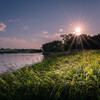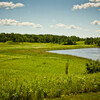
Anishinaabe Wild Rice Experience: Learn how to harvest and prepare wild rice at this family-owned experience in Northwest Ontario

For Rhonda LeClair, owner of Anishinaabe Wild Rice Experience, the arrival of northwestern Ontario’s golden fall days means it’s time to harvest wild rice. Located at Whitefish Lake, about 70 km west of Thunder Bay and about 60 km from the US border, Anishinaabe Wild Rice Experience is a family-owned rice camp. Guests participate in land-based learning, discovering how to harvest and prepare wild rice with a blend of traditional and contemporary methods.
Wild rice is a traditional food of Aboriginal peoples. “My family tells me that our family has always harvested wild rice at Whitefish Lake, going as far back as my great-grandfather and my grandparents,” says LeClair. “My mom remembers being out on the lake when she was a young girl, being in a canoe while her parents would paddle her around.” However, LeClair didn’t learn about harvesting wild rice as a child, although her family enjoyed eating it as a treat. As an adult, she asked her grandparents to teach her, and while they cautioned her that it was hard work, she persevered and found she had a passion for it. Members of the Friday family, like her siblings, mother, aunties and kids joined her. In her first years of learning, LeClair would take the rice to share with members of Seine River First Nation, her mother’s home community, as well as to her home in Pic River First Nation (Biigtigong Nishnaabeg). Soon, LeClair began dreaming of opening a rice camp so others could learn too. “I had this vision of having camps, you know, learning our ways,” she says. “The wild rice just fit.” The company’s mission statement puts it simply: “To preserve a traditional way of life of the Ojibway peoples and to share and teach others how to harvest wild rice.”
About eight years ago she purchased a property on Whitefish Lake, and six years ago she began offering two-day camp experiences, assisted by her son Joshua. Today her students are mainly Indigenous from a variety of elementary, secondary and post-secondary schools. She is considering having an additional camp in fall 2022 that’s open to anyone who is interested, as long as she is able to fill the required numbers of 10 to 20 students per session.
What’s it like harvesting wild rice?

The wild rice season lasts from early September to late October. Whitefish Lake is a shallow lake that has the right growing conditions for wild rice, including muddy soil and optimal water levels. It’s important to LeClair to start each session with grateful words in Anishinaabemowin (Ojibway). “We always have to start out in a good way, and what better way is there than ceremony?” she says. “We always start off with ceremony.”
The group is divided amongst the camp’s five canoes. One person at the bow of the canoe poles the canoe through the rice beds, while the ricer in the stern reaches out with a cedar stick and bends as many stalks of wild rice as possible over the side of the canoe. Then the ricer uses a second cedar stick to gently knock the ripe grains of wild rice into the bottom of the canoe. (Despite the name, wild rice is actually an aquatic grass, not rice.) Back on shore, it’s time for drying. The wild rice needs to be dried immediately, so students spread it out on tarps and scatter it with a rake. Then, they remove debris like pieces of weeds, leaves, stalks and insects. They turn the rice constantly to help with the drying process, which can take from four to 24 hours, depending on the weather conditions.

Visitors learn to patch the rice over a wood fire.
The next step is called parching, where the rice grains are heated over a wood fire in an iron kettle, frequently stirred by a cedar tool. “You parch the rice over heat to stop the germination process,” explains LeClair. This prepares the rice for storage. “Once it’s parched, it has a hull on it that needs to be removed. You could do it a couple of ways. Traditionally, it was the boys who stomped on the rice; they were maybe 10 or 11 years old, with nice clean moccasins,” she says, laughing as she recalls her own children attempting the hull the rice by dancing on it in new white socks. “Or, the contemporary way is to use a machine that removes the hull. I call it my ‘ten little men,’ because it has soft paddles that hit the rice.” A blower removes most of the lightweight chaff. The final part of the process is winnowing, when the rice is placed in a tray (traditionally made of birch bark) and then tossed in the air so the breeze can remove any leftover chaff. The rice is then ready for storing or for cooking. Compared to store-bought wild rice, it is a lighter brown colour, does not need to be soaked before cooking, and cooks in a shorter amount of time.

The rice is placed in a tray (traditionally made of birch bark) and then tossed in the air so the breeze can remove any leftover chaf.
“The students love it,” she says. “They love when I cook the popped wild rice, because it's like popcorn, but better. I'll add blueberries sometimes too.” The wild rice harvest takes a lot of practice, and students may find that their efforts only yield about five pounds of wild rice between 10 people. Still, being out on the land and forging connections with each other and with surrounding wildlife is invaluable. “The beavers are beautiful this time of season. They actually dig up medicines for us,” says LeClair, referring to the water lily roots that beavers excavate from the lake bottom and leave floating on the surface of the water. “When it's ricing season, they dig up that root. In our language it's called akandamoons. We just grab it, and say miigwetch, miigwetch!” She uses the roots to prepare teas.
LeClair also values the spirituality of the wild rice harvest. “My connection to wild rice is very healing. I just feel so peaceful when I’m in the rice fields. I sing to the plants. They nourish me, they protect me, they feed me. My elders talk about how it is such a healing food.”
To learn more, visit www.wildriceexperience.com.
Recommended Articles

Ontario Pow Wow Calendar: 2025 Edition

8 Indigenous Tourism Experiences To Book in 2025

Indigenous Restaurants in Ontario

8 Indigenous Experiences to Discover in North Bay

6 Indigenous-owned Accommodations in Ontario

7 Indigenous-Owned Fishing Experiences in Ontario

Pow Wow Road Trip 2024

11 Indigenous-Owned Outdoor Adventure Companies in Ontario

13 Indigenous-Owned Businesses to Visit on National Indigenous People's Day—and Every Day

A Guide to Visiting the Kay-Nah-Chi-Wah-Nung Historical Centre
Indigenous Theatre on Manitoulin Island
























